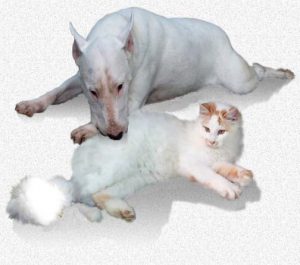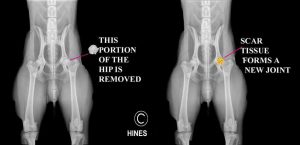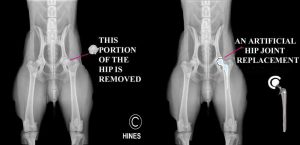Hip Surgery In Your Dog Or Cat
A Femoral Head Osteotomy (FHO) Or A New Replacement Hip?
Ron Hines DVM PhD
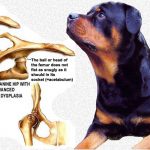 All About hip Dysplasia In Your Dog
All About hip Dysplasia In Your Dog
The hips of our pets are subject to more problems than any other joint in their body. There are a number of reasons your veterinarian might have told you that your pet need hip surgery. If your dog was diagnosed with hip dysplasia, your veterinarian may have recommended it. If your dog or cat was in a car accident or fall, hip surgery might also be necessary. Some breeds and individuals are susceptible to blood supply interruptions that destroy portions of the joint (Legg Perthes Disease) and in some pets, their hips simply wear out
When medications are no longer enough, there are two ways I suggest this problem be treated, femoral head osteotomy, or a total joint replacement. Deciding which of the two methods is best for your pet depends primarily on how much it weighs and the affordability of the treatment. Like any surgery, your pet’s general health must be good enough to undergo surgery and to heal.
Hip Anatomy
The structure of your pet’s hip is quite similar to yours. But since the forces of gravity are directed differently, the shape of the components of your pet’s hip are a bit different from yours. The hips are composed of two bones, the pelvis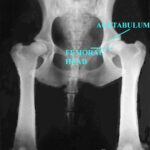
Femoral Head Osteotomy (FHO)
This surgery is also called femoral head arthroplasty, ostectomy or femoral head excision. The most common reason it is performed is when the head and neck of the femur have been broken off from the shaft due to an automobile accident. A second common cause is the eventual arthritis that occurs in the hip joint due to a prior accidental hip dislocation (luxation).
The modified x-ray shown above, represents before and after views of FHO. Every veterinarian performs this technique slightly differently. An incision is made over the hip and the tissues are carefully parted to expose the head (ball) of the femur. This portion of the leg bone is removed, and the remaining shaft is smoothed. Then tissue that surrounded the joint is positioned so that a strong band of connective tissue forms to attach the leg bone (femur) to the pelvis. As this consolidates with additional new scar and cartilaginous tissue, a pseudo-joint forms that is pain free and allows almost natural motion. Some veterinarians also reinforce the area with a very strong flexible surgical sutures anchored to both the femur and pelvis that last for the life of the pet.
It is amazing how well most pet’s bodies adapts to this surgery. However, it is often less successful in dogs that weigh over 45 pounds or elderly pets with slowed healing. Pets with multiple health issues or obesity can also be a challenge.
Joint pain, due to the grinding together of the bones of the hip is completely eliminated. After surgery, the animal maintains its knee a bit straighter to compensate for the slight shortening of the femur.
For the first few weeks after surgery, many veterinarians suggest that the pet be confine to a small cage and have the owner frequently massage the muscles of the leg. By the 4th to 6th week after surgery, they may encourage as much light activity as possible to prevent atrophy (withering) of the muscles of the leg.
Many veterinarians have the owners passively flex and extend the leg and continue massages several times a day. Dogs and cats do quite well on three legs, so it can be difficult to start them using the repaired leg once they are accustomed to walk on three. Sometimes I resort to taping a sock onto their good rear leg to encourage them to use the newly reconstructed joint. I have also found that swimming really hastens recovery and use of the affected leg. Within six months of surgery almost all dogs and cats lope about as if nothing had happened. I love to do this surgery because it is one of the most successful, heartening and emotionally rewarding procedures I perform.
Every veterinarian’s technique and post-surgical instructions will differ somewhat. So follow the directions that your veterinary surgeon gives you.
Total hip replacement (THR)
A total artificial hip replacement (THR) or prosthetic joint is also an option for your pet.
I only consider this procedure in pets that weigh over 40 pounds. In these heavier pets, the FHO technique does not perform well. For these heavier pets, the ball (head of the femur) and socket (acetabulum of the hip) need to be replaced. Although an artificial hip can be placed in any dog or cat whose mature weight is over 5 pounds, I do not suggest the procedure for light animals because the much simpler and cost-effective FHO technique works so well in these lighter animals. However, prosthetic hips are manufactured in all sizes to fit almost all pets.
These devices replace the painful arthritic joint and can be implanted at any stage of the disease. This process has become routine in humans, but cost has limited its use in pets. It is the only technique that works well when dysplasia (severe joint arthritis) is advanced. The modular prosthetic hip replacement system used today has three components, a femoral stem, a femoral head, and the artificial acetabulum. Each component has many available sizes, which allow for a custom fit. The components are made of cobalt chrome, stainless steel or titanium and ultra-high molecular weight polyethylene or another advanced self-lubricating plastic.
This procedure is quite expensive and only performed at large veterinary centers. It has a high success rate and changes in the dog’s mobility can be nothing short of miraculous.
The surgery can be performed on any pet at any age – as long as its general health and basic bone structure is good. Hips are usually replaced one at a time. Often, one replaced hip is enough to restore your pet’s mobility. The surgery must be done when the dog has finished growing so that it will not outgrow the size of the replacement hip. This means it must be 9-12 months old or a bit older, depending on breed.
The technique for total hip replacement in dogs was pioneered by veterinary surgeons at Ohio State University. Their orthopedic group still performs more canine hip replacements than any other university or private practice in the World. If you are considering this surgery for your pet and live in that general area, I suggest you begin your inquires there.
Many veterinary surgeons claim a success rate of 95 percent. This is similar to the success rate in humans. When complications do occur, the most common are separations of the two parts of the artificial joint, infection at the implant site, loosening of the implant and damage to the sciatic nerve. Practice makes perfect – to minimize the chances of such complications, try to choose a facility and surgeon who performs a large number of these procedures.
Some of these implants are cemented into place and some are designed to integrate with existing bone. There is no clear choice as to which system works best. The choice of design is based on your particular surgeon’s preferences as well as your pet’s age, activity level and the density of its bone.
After your pet has this surgery, its exercise needs to be restricted for a month or two. But it should be free of pain almost immediately.
What Can Pet Owners Do to Avoid Dealing With This Problem?
Keep your pet trim. Overweight pets place more stress on all their bodies joints and ligaments.
Feed a nutritionally balanced diet.
Limit activities that put undo stress on your pet’s hips. Out of love, dogs will do almost anything for you if you ask them too. Sometimes they exert their bodies and joints more than they should. Just as human athletes often require joint replacements too soon, pets that overwork themselves can too.
Do not spay or neuter your pets until they are fully mature. Read about the dangers of neutering your dog and cat at too young an age. Read about that here. Sex hormones are critical for normal bone, ligament and muscle development and maintenance.
You are on the Vetspace animal health website
Visiting the products that you see displayed on this website help pay the cost of keeping these articles on the Internet.

